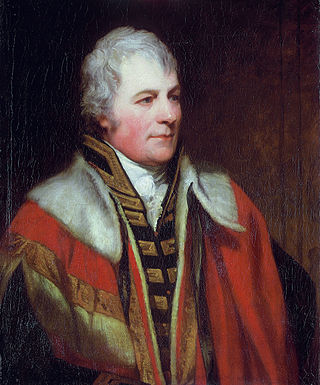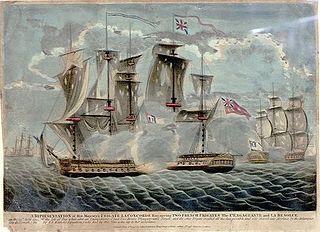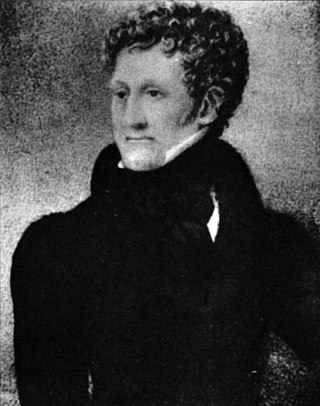
Admiral Edward Pellew, 1st Viscount Exmouth, GCB was a British naval officer. He fought during the American War of Independence, the French Revolutionary Wars, and the Napoleonic Wars. His younger brother Israel Pellew also pursued a naval career.

Admiral William Carnegie, 7th Earl of Northesk was a British naval officer who served during the American Revolutionary War, French Revolutionary War, and Napoleonic Wars. While in command of HMS Monmouth he was caught in the Nore Mutiny of 1797 and was the officer selected to relay the demands of the mutineers to George III. He most notably served as third-in-command of the Mediterranean Fleet at the Battle of Trafalgar in HMS Britannia. He later became Rear-Admiral of the United Kingdom and Commander-in-Chief, Plymouth.

America was a Téméraire-class 74-gun ship of the line of the French Navy. The Royal Navy captured her in 1794 at the Glorious First of June. She then served with the British under the name HMS Impetueux until she was broken up in 1813. She became the prototype for the Royal Navy America-class ship of the line.

HMS Cleopatra was a 32-gun Amazon-class fifth-rate frigate of the Royal Navy. She had a long career, seeing service during the Fourth Anglo-Dutch War, and the French Revolutionary and Napoleonic Wars. During the latter wars she fought two notable engagements with larger French opponents. In the first engagement she was forced to surrender, but succeeded in damaging the French ship so badly that she was captured several days later, while Cleopatra was retaken. In the second she forced the surrender of a 40-gun frigate. After serving under several notable commanders she was broken up towards the end of the Napoleonic Wars.
His Majesty's Hired armed lugger Duke of York served the Royal Navy from 14 October 1794 to 2 January 1799 when she foundered in the North Sea.

Concorde was a 32-gun frigate of the French Navy, lead ship of her class. Built in Rochefort in 1777, she entered service with the French early in the American War of Independence and was soon in action, capturing HMS Minerva in the West Indies. She survived almost until near the end of the war when HMS Magnificent captured her in 1783. Not immediately brought into service due to the draw-down in the navy after the end of the war, Concorde underwent repairs and returned to active service with the outbreak of war with France in 1793 as the fifth-rate HMS Concorde.

Savage Mostyn was an officer of the Royal Navy who saw service during the War of the Austrian Succession and the Seven Years' War. He embarked on a political career, and was a Member of Parliament, Comptroller of the Navy, and one of the Lords of the Admiralty.
James Young was an officer of the Royal Navy who saw service during the French Revolutionary and Napoleonic Wars, rising to the rank of vice-admiral of the white.
HMS Aeolus was a 32-gun Amphion-class fifth-rate frigate of the Royal Navy. She was launched in 1801 and served in the French Revolutionary and Napoleonic Wars, and the War of 1812.

John Bastard of Sharpham, Ashprington, Devon, was an officer of the Royal Navy who saw service during the French Revolutionary and Napoleonic Wars, and the War of 1812, rising to the rank of post-captain. He also entered politics and became a Member of Parliament.

Philemon Pownoll of Sharpham in the parish of Ashprington in Devon, England, was an officer of the Royal Navy who saw service during the War of the Austrian Succession, the Seven Years' War and the American War of Independence, rising to the rank of post-captain.

Charles Inglis was an officer of the Royal Navy who saw service during the War of the Austrian Succession, the Seven Years' War, and the American War of Independence, rising to the rank of rear-admiral.

HMS Prince William was a 64-gun third-rate ship of the line of the Royal Navy. She had previously been Guipuzcoano, an armed 64-gun ship of the Spanish (Basque) mercantile Guipuzcoan Company of Caracas. She was also known by the religious name of Nuestra Señora de la Asunción.

Rear-Admiral James Macnamara was an officer of the Royal Navy who served during the American War of Independence and the French Revolutionary and Napoleonic Wars.

HMS Nymphe was a fifth-rate frigate of the British Royal Navy, formerly the French Nymphe, lead ship of her class. HMS Flora, under the command of Captain William Peere Williams, captured Nymphe off Ushant on 10 August 1780. Indiscriminately referred to as Nymph, Nymphe, La Nymph or La Nymphe in contemporary British sources, she served during the American, French Revolutionary and Napoleonic Wars. On 19 May 1793, while under the command of Captain Edward Pellew, she captured the frigate Cléopâtre, the first French warship captured in a single-ship action of the war. After a long period of service in which she took part in several notable actions and made many captures, Nymphe was wrecked off the coast of Scotland on 18 December 1810.
HMS Resolution was a cutter that the Royal Navy purchased in 1779. She captured two French privateers in 1781 and a Dutch privateer in 1783 after a single ship action. Resolution captured one more small French privateer in June 1797; later that month Resolution went missing in the North Sea, presumed to have foundered.
The action of 12 December 1779 was a minor naval engagement that took place in the Bay of Honduras during the American Revolutionary War between a British Royal naval Fourth-rate fifty gun ship and a fifty gun Spanish privateer.
HMS Kingfisher was an 18-gun sloop of the Royal Navy which saw service during the American War of Independence and the French Revolutionary Wars.
The action of 13 August 1780 was a minor naval battle fought off the Old Head of Kinsale in which the 64-gun French "private man of war" (privateer) Comte d'Artois fought two British Royal Navy ships, Bienfaisant and Charon, during the American Revolutionary War.

HMS Glory was a 32-gun fifth-rate Niger-class frigate of the Royal Navy, and was the second Royal Navy ship to bear this name.












